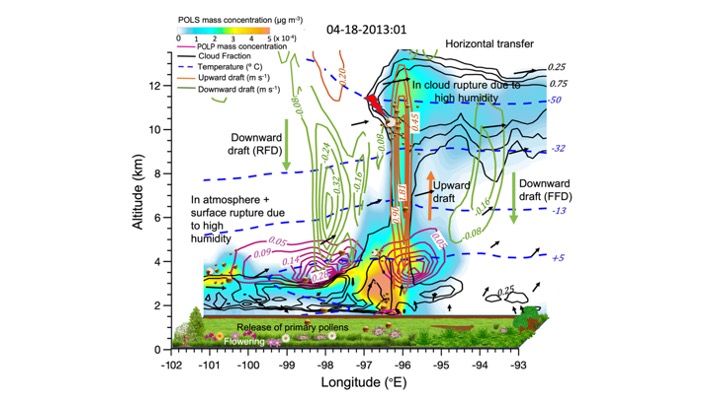Simulating the journey of pollen in the atmosphere
Submitter
Steiner, Allison L
— University of Michigan
Subba, Tamanna — University of Michigan
Area of Research
Aerosol Processes
Journal Reference
Subba T, Y Zhang, and A Steiner. 2023. "Simulating the Transport and Rupture of Pollen in the Atmosphere." Journal of Advances in Modeling Earth Systems, 15(3), e2022MS003329, 10.1029/2022MS003329.
Science

Figure 1. Vertical cross-section illustrating primary pollen (POLP; pink contours) and pollen ruptured particles (POLS; color contours) during the initial stage of the simulated thunderstorm. Rear-flank downdraft (RFD) and forward-flank downdraft (FFD) indicate how ruptured pollen may be returned to the surface. From journal.
Pollen, one type of primary biological aerosol particle, is released from vegetation and can be physically transformed in the atmosphere by rupturing into smaller particles. This study uses an atmospheric model to understand how pollen breaks apart in the atmosphere and its effects on cloud formation processes.
Impact
Aerosol particles such as pollen can influence health by causing seasonal allergies, and smaller ruptured particles can trigger asthmatic events. Here we develop a new modeling tool to understand how pollen may change in the atmosphere and its impacts on health and climate.
Summary
Biological aerosols such as pollen are released from the land into the air and have impacts on atmospheric processes, climate, and human health. Depending on atmospheric conditions, large pollen particles can rupture and produce smaller fragments. These fragmented particles have the potential to trigger a phenomenon known as thunderstorm asthma. A coupled meteorology-chemistry model (WRF-Chem) simulated the amount of pollen in the atmosphere and potential pathways for atmospheric rupture. The model simulations revealed that three pollen rupture mechanisms, including high-humidity-induced surface rupture, in-atmosphere-plus-surface rupture, and lightning-induced rupture, affect the overall pollen concentration in the Southern Great Plains during days with intense pollen emissions. The highest concentrations of small pollen particles were observed in both the atmosphere and on the surface due to humidity-induced rupture, while pollen rupture events triggered by in-cloud and cloud-to-ground lightning strikes were less significant. These smaller, ruptured pollen particles are transported vertically through updrafts, horizontally through cloud outflows, and finally reaching the surface through downdrafts. In regions with high pollen levels and strong convection, these ruptured particles can modify hydrometeors and influence cloud formation.
Keep up with the Atmospheric Observer
Updates on ARM news, events, and opportunities delivered to your inbox
ARM User Profile
ARM welcomes users from all institutions and nations. A free ARM user account is needed to access ARM data.


















